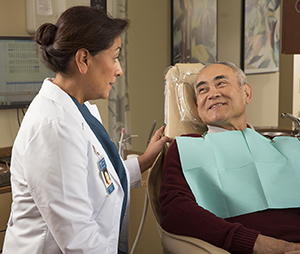Dental Implants: The Right Prosthesis for You

If you have one or more missing teeth, your dentist may recommend dental implants. A dental implant is an artificial tooth root. Your jawbone fuses with the implant to provide a secure platform for a prosthesis (artificial tooth). A dental prosthesis is secured to one or more implants. The prosthesis you have will depend on your dental needs. Your dentist will work with you to find the right prosthesis for you.
A prosthesis to fit your needs
Depending on how many teeth you’re missing, you may have a single, partial, or complete prosthesis. The more teeth to be replaced, the more implants you will need. For most people, a lasting (permanent) prosthesis won’t be made until the jawbone has fused to the implants. Until then, a temporary prosthesis may be used:
-
Single prosthesis. This is used to replace a missing tooth. One implant is all that’s needed for support.
-
Partial prosthesis. This replaces two or more teeth. Two or three implants are used for support.
-
Complete denture prosthesis. This replaces all the teeth in an upper or lower jaw, or both. The number of implants needed depends on whether a fixed or removable prosthesis is used.
If you need a complete prosthesis
There are two types of complete denture prostheses: removable and fixed. Both can be used to replace a complete set of teeth. Removable means you’ll be able to take it out of your mouth. Fixed means it can only be taken out by a dentist. You and your restorative dentist can discuss which type is best for you.
-
Removable prosthesis. With a removable prosthesis, the new teeth are joined to the implants by a connecting device, like a clip and bar. This allows you to take the prosthesis out for cleaning. For support, this type often uses 4 to 6 implants per jaw.
-
Fixed prosthesis. With a fixed prosthesis, the new teeth are fitted to a frame that is secured to the implants. Five or more implants are placed along the jaw. In some cases, a fixed prosthesis offers more stability for chewing.
Online Medical Reviewer:
Jessica Gotwals RN BSN MPH
Online Medical Reviewer:
Michael Kapner MD
Online Medical Reviewer:
Rita Sather RN
Date Last Reviewed:
12/1/2022
© 2000-2025 The StayWell Company, LLC. All rights reserved. This information is not intended as a substitute for professional medical care. Always follow your healthcare professional's instructions.